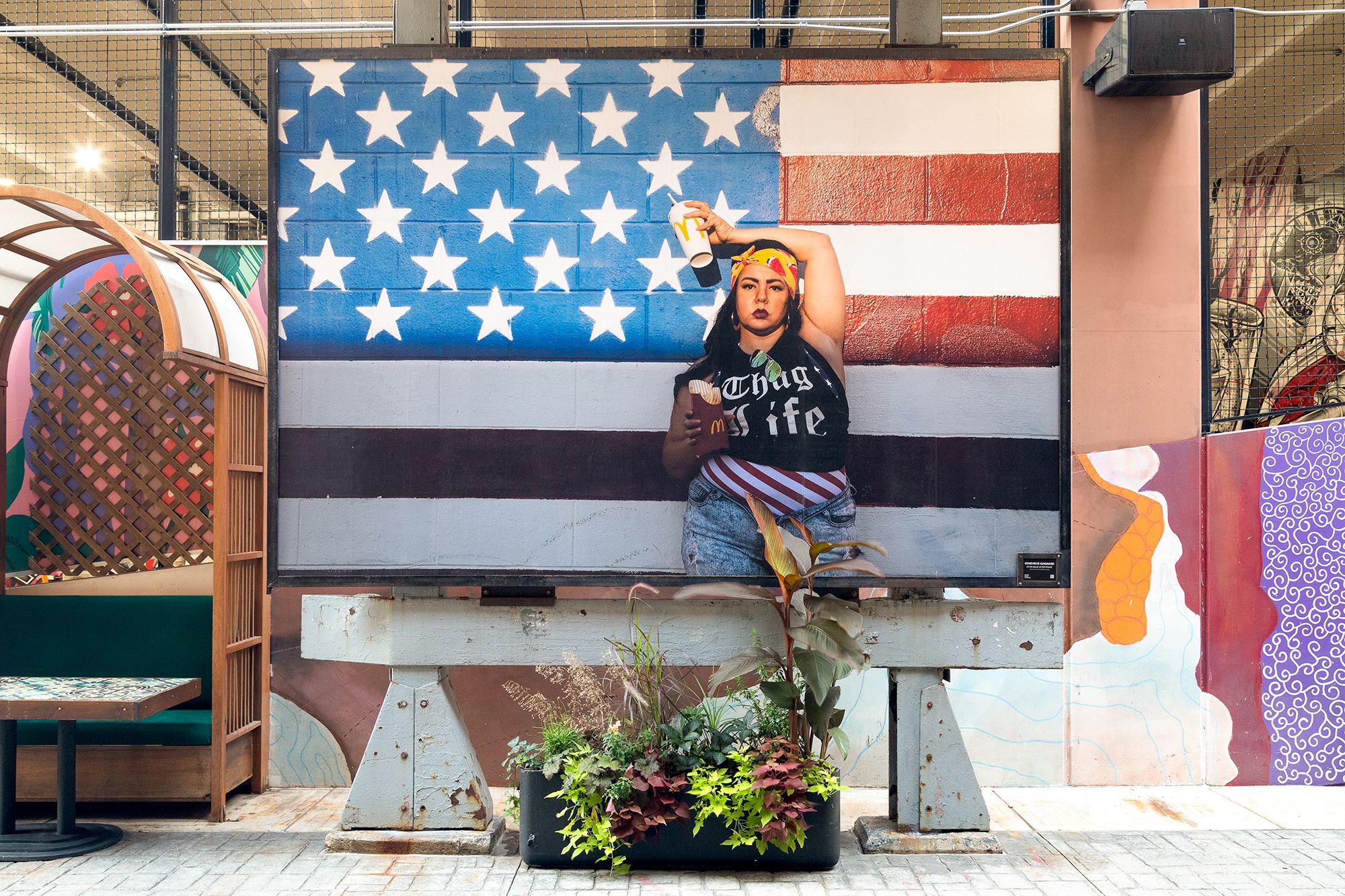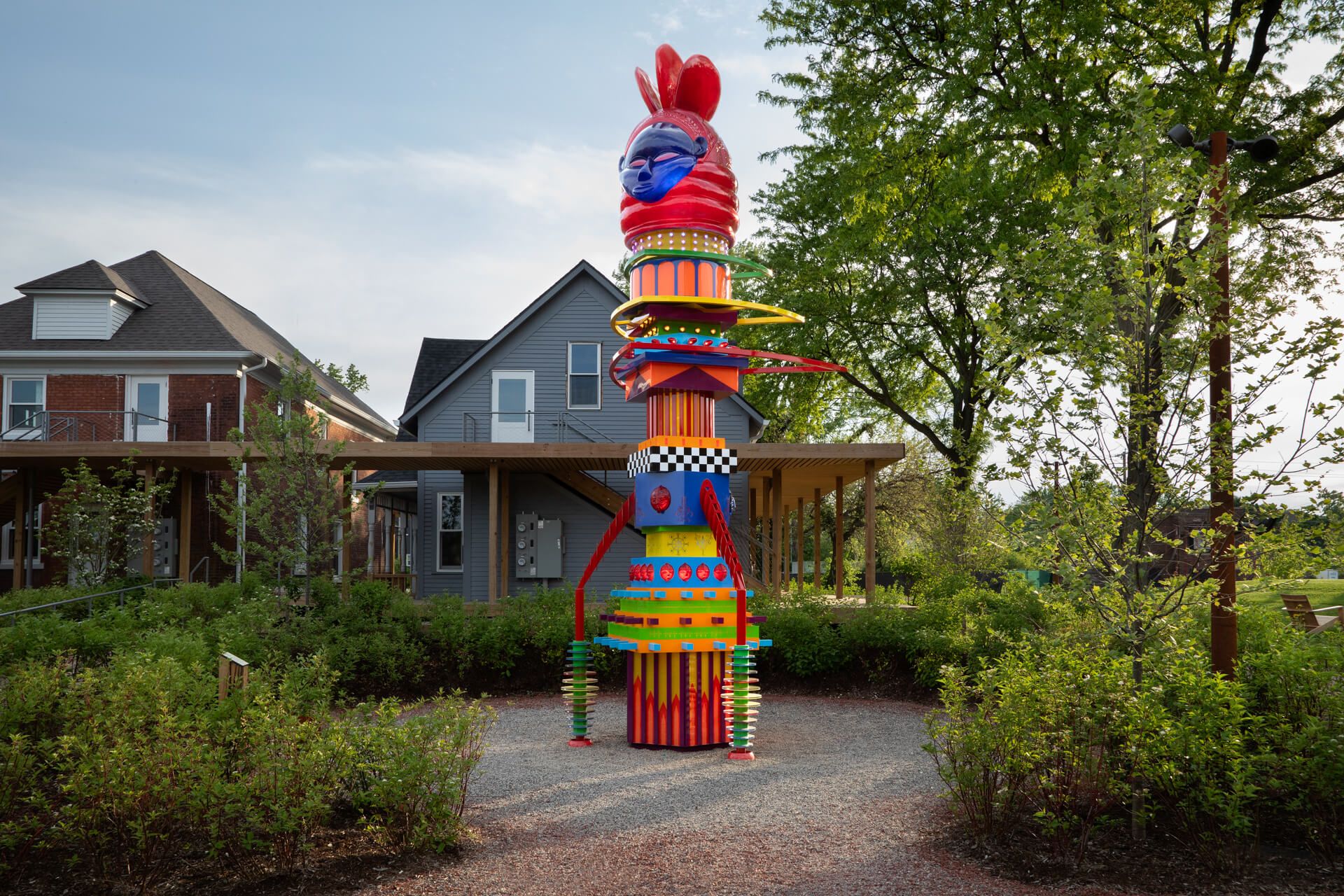
Press Release

Installation views of In an effort to be held
Photos by Joseph Tiano
Artists: Kevin Beasley, Celeste, Bethany Collins, Ed Clark, Shane Darwent, Jordan Eagles, Yatika Starr Fields, Sam Friedman, Genevieve Gaignard, Cameron Harvey, Evan Holloway, Lotus L. Kang, Wangechi Mutu, Natani Notah, Angel Otero, Zak Ové, Naudline Pierre, Christina Quarles, Kellie Romany, Ilana Savdie, Karen Seapker, Manal Shoukair, Richard Tuttle, Paul Verdell, Kennedy Yanko, Cullen Washington, Jr.
Library Street Collective is pleased to present In an effort to be held, a group exhibition of over twenty artists working across media, who have developed experimental approaches to material and form, opening at the Shepherd on August 3, 2024. Curated by Allison Glenn, Artistic Director of the Shepherd, In an effort to be held considers the aesthetics of surface, and the processes of engaging the surface through transfer, collage, wrapping, and in some more literal cases, artists who consider how materials hold histories, mirror and imply surface, skin, and bodies, with consideration for the terrestrial, hidden, mythological, and celestial.
In an effort to be held includes artists who engage in transference, collage, and casting processes, re-presenting found materials to convey the histories they carry. Angel Otero creates dynamic, large-scale abstractions by representationally painting onto glass, scraping at the surface to dismantle the composition into fragments that are reassembled into stratified compositions. Embracing the idea that materials hold memories both personal and ubiquitous, Splintered (2019) is created from collaged, cut-out pieces of earlier oil paint, salvaged from the studio and recontextualized into an assemblage painting that incorporates pieces of woven cane. The undulating surface of Kevin Beasley’s Site XXXIII (2023) holds strips of fabric and textiles–including altered t-shirts and raw cotton from the artist’s home state of Virginia–that are embedded into the dyed-resin encased surface, alluding to what we keep and the truths we hold. Created from paper and granite dust sourced from old Confederate monuments, Bethany Collins’ Old Ship series (2023) is based on ornamental details found on the Corinthian columns enclosing the sanctuary of the Old Ship AME Zion Church, the oldest Black church in the artist’s hometown of Montgomery, AL. Each cast pays homage to the building and congregation that hosted prominent Black speakers like Frederick Douglass, Senator Blanche K. Bruce, and Dr. Booker T. Washington. The seductive ripples of paint that cascade across the large-scale, twisted metal in Kennedy Yanko’s sculpture are created by folding, bending, and further manipulating sheets of semi-dried acrylic paint around metal found in scrap yards.
Through an uninhibited consideration of surface and edge, many artists interrogate the boundaries of their bodies, and the permeability of binary classifications. Articulating the illusory ideas of identity through a signature style of painting that destabilizes the viewers' perception, Christina Quarles’ shape-shifting bodies transform across the pictorial plane of a canvas, walls, and often-times the entirety of galleries. The casually entangled bodies depicted in Honey n’ Smoke (2022), for example, languidly drape across a hard-edged, angular line that bisects the richly complex composition, complicating the perspective. Through her often-times surrealistic compositions, Ilana Savdie’s large-scale beeswax, oil, and acrylic paintings contain multitudes. Painting to the scale of her own body, the intertwined bodies found within Savdie’s otherworldly compositions include shapeshifters, such as the marimonda–or trickster–figures of Brazilian Barranquilla Carnival and parasites, seen by Savdie as body snatchers, or agents of change. Overall, Savdie considers the unfixed and fluid qualities of bodies and identity, and the tensions through which a third, or liminal, space emerges. The titles of Wangechi Mutu’s watercolors–Metastasis III and Metastasis IV (2016) refer to the cellular growth and relocation of a pathogenic agent in a hostbody. The delicately interwoven shapes are plant-like, amoebic, and corporeal, suggesting an interconnectedness inherent in all life forms. Moving her entire body across unstretched, shaped canvases Cameron Harvey’s Ancestors consider the limits of her form. Impressing her body into paint she creates from plants sourced on long walks in Los Angeles, Harvey sees her paintings as protective bodies that hold space for the viewer to contemplate their own relationship to the present moment, their physical body, and their similarities to other forms in nature. Sweeping paint across the surface of canvas with a push broom became Ed Clark’s iconic approach to abstraction. Fully engaging the liveliness of his body in each application of paint and pigment, each mark made by the broom becomes an extension of Clark himself. Patel Wheel (1989) is a uniquely pastel picture from a moment late in the artist’s career, where the expressionistic marks softened and the paint became looser, and more fluid like. The pigments of the pooling paint found in the center of Kellie Romany’s palm sized ceramic vessels are taken from a controversial and inconsistent early 20th-century chromatic scale of skin tones created by Felix von Luschen, which he used to establish racial classifications. Inviting viewers to hold, move, and rearrange the vessels, with In an effort to be held (2018), Romany asks us to consider our interconnected relationship to our bodies, all bodies, and the world around us. Further engaging with this dialogue of bodies and the environment, Karen Seapker’s extraterrestrial forms combine Greek mythologies with the natural world. Sisyphus with Seedling (2024) presents the myth of Sisyphus, a King forever condemned by the gods to push a rock up the mountain in Hades, as punishment for his unspeakable behavior towards fellow humans, met with a seedling that promises new life and hope while also considering the cyclical nature of things so intrinsic to Sisyphis’s enduring retribution.
In an effort to be held also reflects on the fragility and form of materials, incorporating artists–including Lotus L. Kang, Kennedy Yanko, Manal Shoukair, and Angel Otero–who anthropomorphize media, referring to the paint, film, silicone, and nylon they use as "skins", asking the viewer to consider the implications of these references in these exceedingly fragile times.
Surface, materiality, spirituality, and mythology are further explored in the work of Wangechi Mutu, Naudline Pierre, Paul Verdell, ZakOvé, Jordan Eagles, and Evan Holloway. Thick, gestural marks of vibrant color span Paul Verdell’s canvases. Verdell’s freeform experimentations in expressionistic mark making are intuitive in nature, as the artist works by communicating a feeling or emotional state from memory, articulating it through the application of oil stick and paint on canvas. Similarly accessing the otherworldly, Evan Holloway creates automatic pen and ink drawings–which he refers to as “Scrys”–with his eyes closed while a large piece of paper rotates on a turntable he created. To scry is to foretell the future through a reflective surface; for Holloway, this automatic process provides an opportunity to see through to another space, world, or environment. With Automatic Drawing, Late June, (2023) Holloway has layered multiple Scrys together, evidenced by the blue line drawing seen through the fissures that emerge in the folds of the first layer of the drawing. The contrast and balance between the formal elements of light and shape are the anchors for Zak Ové’s tondo paintings, which are circular works made of colorful, vintage cotton doilies. A circle of deep purple surrounds the central oculus of DP70 (2023), suggesting a celestial night sky. The ripped and textured edges of paper that contained the layered wash drawings in Naudline Pierre’s Creatures of Love (2023) hold Pierre’s signature unearthly creatures, ensconced by a custom metal frame. Referencing her interest in sacred architecture, this work is her take on a traveling, or miniature, altarpiece.
Considerations of space and environment are articulated through loans, site-specific installations, and new commissions. Nylon-encased pomegranates suspended from an oculus into the center of the galleries meet the site line of the altar. In Islam, the pomegranate is considered a sacred fruit found in paradise, and at the Shepherd, their symbolism combines with the religious iconography of the former Catholic Church, offering multiple ideas of reverence and ritual. This site-specific installation by Manal Shoukair is meant to be experienced from multiple vantage points; inviting the viewer to consider hybridity so intrinsic to Shoukair’s lived experience, multicultural identity, and Islamic spirituality. La constelación que viene (2023) is a multi-panel dyed cotton canvas work with pigments and an acrylic base, created by María Fernanda Camarena and Gabriel Rosas Alemá, the artist collaborative Celeste. An interest in shifting commonly-held modes of display has led Celeste to create a series of textile works that drape, fold, and plunge into gallery spaces. Placed above the former altar, the constellation of symbols on La constelación que viene (English translation The constellation is coming) represent both celestial bodies and celestial interactions. A new work from Yatika Starr Fields continues the artist’s Tent Metaphor series, created from tents salvaged from destroyed Standing Rock encampments, continuing to recognize our relationships to land where tents appear daily, including in our communities. Holding space for dialogues on temporality, including the past and present and what is necessary for the future, Fields’ intends for the work to reevaluate the continued need to protect the human spirit and condition.
Two artist’s works included In an effort to be held will be exhibited publicly for one year, further contextualizing the reach of the larger campus and the desire to provide accessible viewing opportunities in public space. For one year, Genevieve Gaignard’s Public Matter will be on view across a series of billboards in The Belt. Gaignard’s photography and collage-based practices reference art history, the personal, and pop-culture. The selection of images chosen for The Belt are from an ongoing body of self-portraits where Gaignard has manipulated her clothing, make-up, and hair to present versions of herself that undermine, question, and poke fun at beauty standards, social hierarchies, and, at times, phenotypic assumptions of race. With Compton Contrapposto, for example, we see Gaignard’s character donning a blonde afro, standing in front of a green Cadillac Deville. The character’s contrapposto–or counter pose–was invented in the early 5th century by the Greeks, often used in large figurative sculpture and paintings. Created in front of a Deville in the Compton neighborhood of Los Angeles, the birthplace of notable rappers Dr. Dre, Kendrick Lamar, and Ice Cube, the title’s clever alliteration points to a bricolage of influences underscored by Gaignard’s intersectional identity. Zak Ove’s The Mothership Connection, a 26-foot tall illuminated sculpture, will be on view on the Shepherd’s campus, immediately adjacent to the former church, where DP70 (2023) will be on view. With The Mothership Connection, Ové seeks to reveal the often-times invisible histories of enslaved Africans and indentured laborers in the development of historic buildings in the United States alongside African and African Diasporic architecture and design. The base of this 26-foot rocket-shaped sculpture references the Djenné mud mosque of Mali. The trunk is adorned with luminous tribal masks and etched Veve symbols, found within African Diasporic culture in Haiti. The upper layers echo masonic architecture with columns and triangles and a ring of Cadillac lights referencing the Motor City, Western design, and consumerism. The final layer mimics the arches of The Capitol Building, in Washington, D.C. and at the very top sits an enlarged female Mende tribal mask. An internal light bestows a radiant pulse and heartbeat, The Mothership Connection is a literal and enduring beacon to the future. A reference to Parliament Funkadelic’s 1975 iconic concept album Mothership Connection, partially recorded at United Sound Studios in Detroit, this work is a reference to a future where Black people are included in all possible frames of reference.
In an effort to be held is on view from August 3 - October 12, 2024 at the Shepherd.
Install Images

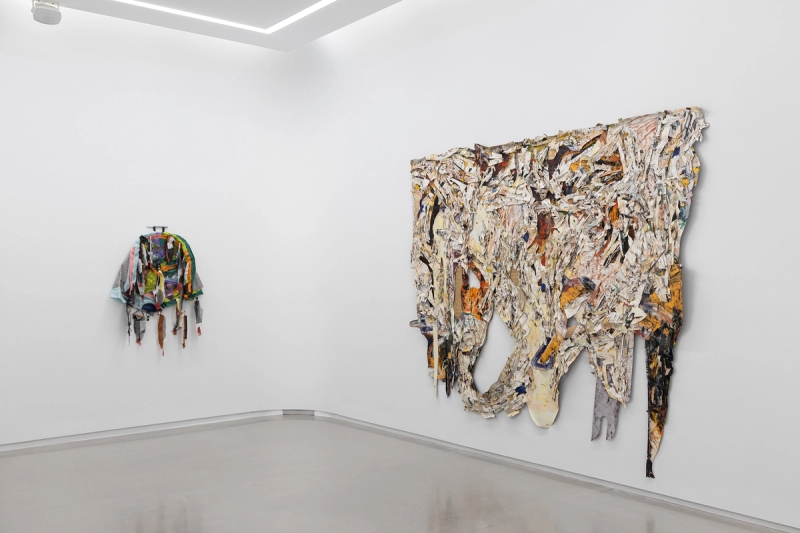



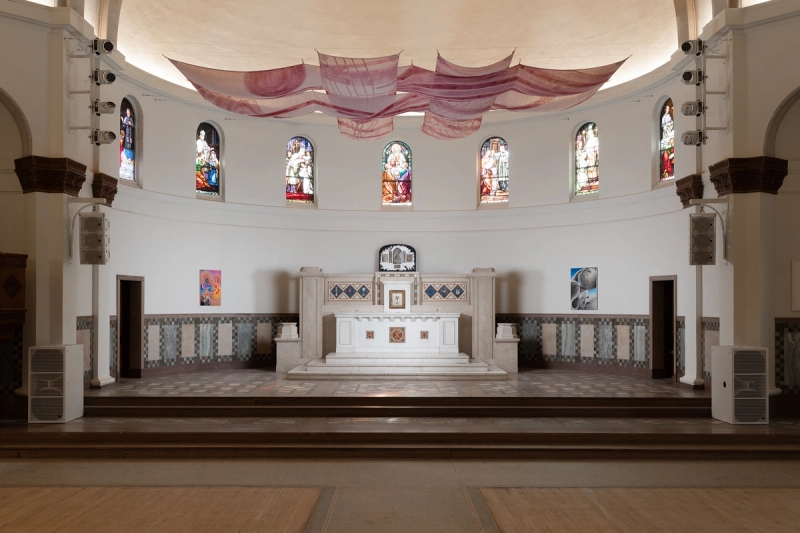

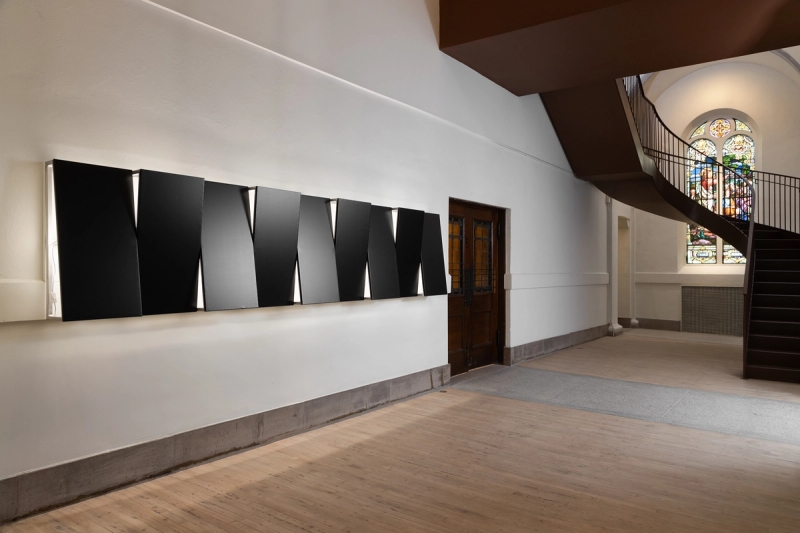
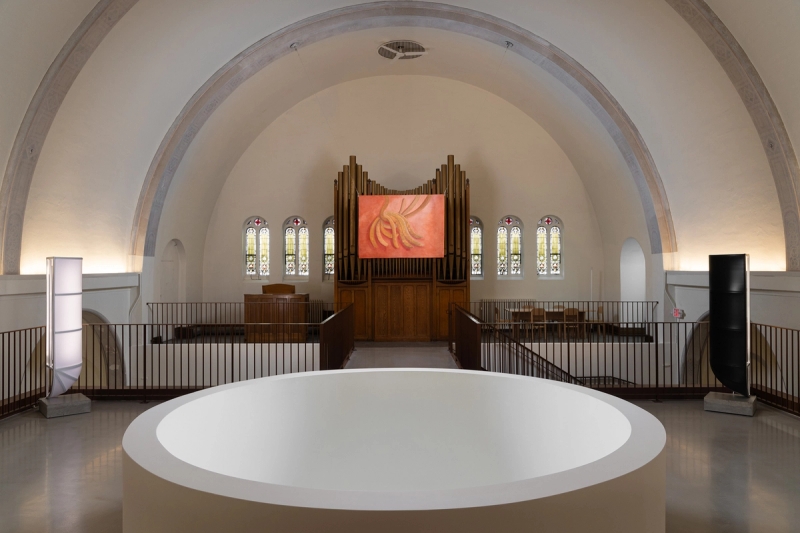
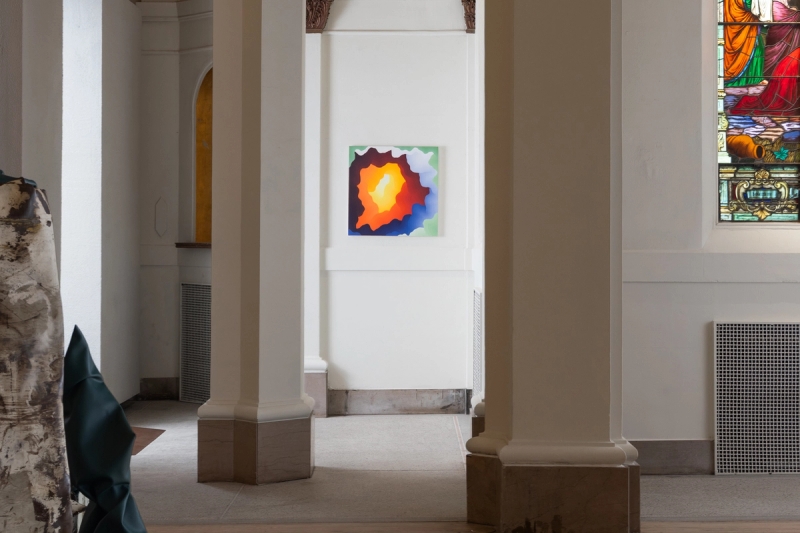
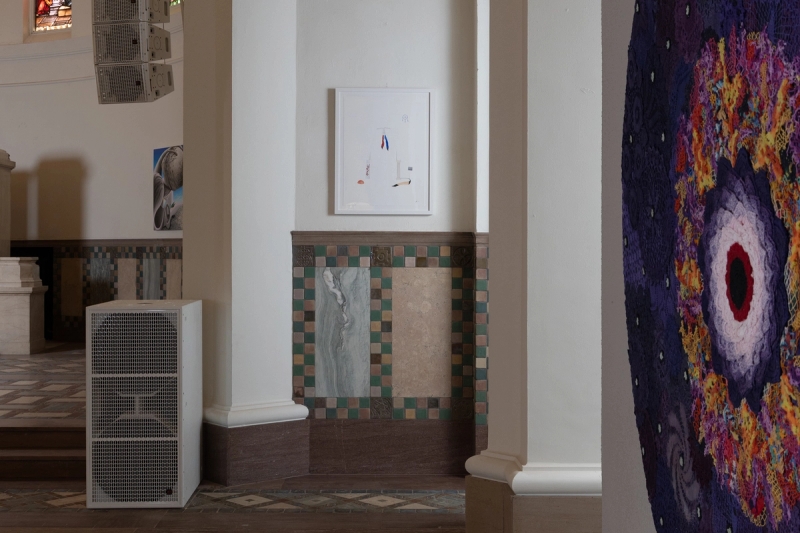
Artwork Images

Kevin Beasley
Site XXXIII, 2023
Polyurethane resin, raw Virginia cotton, altered housedresses, confetti t-shirts, altered t-shirts, fiberglass
50.5h x 74.5w x 2d in
Photo by Jason Wyche. Courtesy of the Artist and Casey Kaplan, New York.

Christina Quarles
Honey n' Smoke, 2022
Acrylic on canvas
86.25h x 96.25w x 2d in
© Christina Quarles
Courtesy the Artist, Hauser & Wirth, and Pilar Corrias, London

Kennedy Yanko
Intimacy of throes, 2024
Paint skin and metal
152h x 186w x 105d in

Wangechi Mutu
Metastasis III and Metastasis IV, 2016
Watercolor on paper
Diptych: 16.125h x 12.125w in
Photo by Robert Wedemeyer. Courtesy of the Artist and Vielmetter Los Angeles.

Angel Otero
Splintered, 2019
Oil skins on fabric
106h x 124w x 5d in
© Angel Otero. Photo by Matthew Herrmann. Courtesy the Artist and Hauser & Wirth.

Cullen Washington, Jr.
Primer 20, 2023
Earth mineral pigments, soot, carbon, acrylic and medium on paper in artist frame
31h x 47w in

Ed Clark
Patel Wheel, 1989
Acrylic on canvas
55h x 70.5w in
© The Estate of Ed Clark. Courtesy the Estate and Hauser & Wirth. Photo by Sarah Muehlbauer.

Genevieve Gaignard
Compton Contrapposto, 2016

Richard Tuttle
Calder Corrected, 1, 2022
Acrylic, pencil, and cut paper
14h x 22w in
© Richard Tuttle. Courtesy of Pace Gallery.
